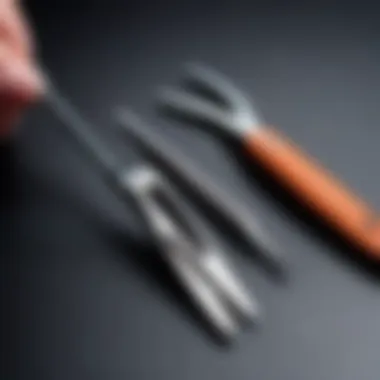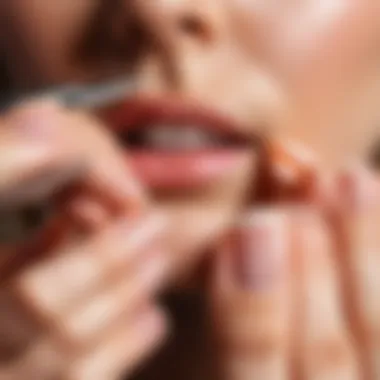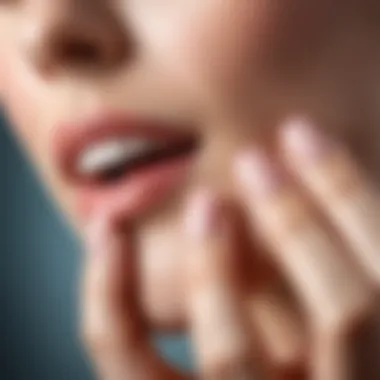Mastering Cuticle Care: Trim at Home Like a Pro


Intro
Maintaining healthy cuticles is essential for overall nail health and aesthetics. Cuticles protect the nail matrix from infections and foreign substances. However, improper care can lead to painful hangnails and other issues. Trimming them at home can be a simple yet effective way to keep them looking neat and healthy.
In this guide, we will delve into the specifics of cuticle trimming. This includes the tools required, a step-by-step process for trimming, and important aftercare practices. The goal is to help both men and women of all ages enhance their nail care routine safely at home.
Popular Offers and Promotions
While focusing on cuticle care, it is equally important to consider the products used. Many beauty brands often have promotions and offers that can be beneficial. It’s worth checking current discounts on brands like OPI, Sally Hansen, or Essie. They frequently provide seasonal sales or special promotions which make it cost-effective to purchase quality nail care items.
Overview of Current Discounts on Cosmetic Brands
Different brands provide various options when it comes to nail care tools and products. Look for:
- Buy one, get one 50% off discounts on nail treatment products.
- Seasonal bundles that often include essential tools like cuticle nippers and nail oils.
Seasonal Sales and Special Offers
Consider keeping an eye on the following periods for attractive deals:
- Spring sales when many brands refresh their collection.
- Holidays like Black Friday or Cyber Monday often feature attractive discounts particularly on beauty products.
Staying updated can help save money while ensuring you have the right tools for cuticle care.
Recommendations for Choosing Cosmetic Products
When selecting cosmetic products, it is critical to consider your skin type and specific needs. The right tools lead to better results.
How to Choose Cosmetic Products by Skin Type
Different skin types react differently to products. Those with sensitive skin should opt for products without harsh chemicals. Always look for:
- Hypoallergenic formulations.
- Natural ingredients like jojoba oil or vitamin E available in cuticle oils.
Tips for Choosing Products for Different Age Groups
As individuals age, skin and nail care requirements change. Here are some tailored tips:
- Younger individuals: Focus on basic tools and maintaining moisture in cuticles.
- Older individuals: Seek treatments aimed at strengthening nails and reducing brittleness.
Understanding product specifications and promotions can assist in making informed decisions for nail and cuticle health, setting the stage for successful at-home cuticle trimming.
Understanding Cuticles
The cuticle, often overlooked, plays a significant role in nail health and aesthetics. It is the thin layer of skin at the base of the nail, protecting the area from potential infections and damage. Understanding what cuticles are and their functions is important for anyone interested in maintaining healthy nails. This section aims to demystify cuticles and highlight their importance in a comprehensive nail care routine.
What Are Cuticles?
Cuticles are made of dead skin cells that form a protective barrier at the nail bed's base. They are essential in safeguarding the underlying skin from microorganisms and environmental aggressors. Each cuticle adapts to the individual, varying in thickness and appearance. Healthy cuticles are generally soft and smooth, contributing to an overall neat appearance.
The Role of Cuticles in Nail Health
Cuticles serve crucial functions in maintaining the health of the nails. They prevent dirt, bacteria, and other harmful elements from penetrating the nail matrix. A well-cared-for cuticle can also promote stronger nail growth. Regular maintenance helps avoid hangnails and splits that can be painful and lead to further complications. Furthermore, when nails grow without obstruction from damaged cuticles, their strength and integrity improve.
"Maintaining cuticles is as important as caring for the nails themselves."
Common Myths About Cuticles
There are several misconceptions surrounding cuticles that can lead to improper care. One common myth is that cuticles should be cut away entirely. While over-trimming can cause damage, the goal should be to maintain healthy cuticles, not to remove them completely. Another myth is that pushing back cuticles will cause them to grow thicker. In reality, gentle care promotes healthier growth patterns. By understanding these myths, individuals can make more informed decisions about their cuticle care practices.
Why Trim Cuticles?


Trimming cuticles is an essential aspect of nail care that contributes significantly to both aesthetics and health. The cuticle, a layer of skin at the base of the nail, serves to protect the nail matrix from debris and bacteria. However, overgrowth can lead to several issues that affect appearance, hygiene, and nail growth. Understanding why trimming cuticles is important sets the foundation for effective nail care practices.
Aesthetic Considerations
Trimmed cuticles present a clean and polished look to nails. When cuticles grow too long, they can create a ragged appearance that detracts from nail artistry, whether it is simple varnish or elaborate designs. Regular trimming allows a neater presentation of nails, enhancing overall hand aesthetics. It is particularly important for individuals who, whether for personal or professional reasons, wish to maintain an immaculate appearance. A well-groomed nail bed contributes to confidence in social and work scenarios.
Preventing Infections
One of the primary benefits of trimming cuticles is the prevention of infections. Untrimmed or overgrown cuticles can shield dirt and bacteria, making it easier for germs to enter the skin. This can lead to painful conditions like paronychia, which is an infection around the nail. By regularly trimming cuticles, individuals can minimize this risk, keeping nails and surrounding skin healthy. Maintaining this aspect of nail hygiene contributes not only to physical well-being but also to self-care routines that emphasize health and cleanliness.
Promoting Healthy Nail Growth
Healthy cuticle care can play a crucial role in promoting nail growth. When cuticles encroach upon the nail bed, it may restrict the growth of new nail cells. Trimming cuticles helps to maintain an unobstructed area for nails to grow, ensuring that nails can develop freely. Additionally, a nourished cuticle often leads to stronger and more resilient nails. Therefore, by incorporating regular trimming into a nail care routine, individuals can positively influence the overall strength and health of their nails, leading to better outcomes in their nail care endeavors.
Essential Tools for Trimming Cuticles
Trimming cuticles at home is an art that necessitates the right instruments. Using proper tools not only makes the process easier but also ensures safety and effectiveness. Cuticle care requires specific tools designed to handle the delicate skin around nails. Choosing tools carefully will enhance your at-home manicure experience and promote healthier nails.
Cuticle Nippers
Cuticle nippers are essential for trimming away excess cuticle skin. These specialized tools feature sharp, pointed edges to allow for precise cutting. Their design enables users to remove stubborn cuticles without causing damage to the surrounding skin. Using quality cuticle nippers minimizes the risk of snagging or tearing, which can lead to discomfort or infections. It is advisable to select nippers made from stainless steel for longevity and easy cleaning.
Cuticle Pushers
Cuticle pushers play a crucial role in cuticle care. They are used to gently push back the cuticle and clean the nail bed area. A good cuticle pusher can help in lifting the cuticle away from the nail, ensuring that it does not interfere with the growth of the nail plate. When selecting a pusher, consider a tool with a comfortable handle. This ensures ease of use, allowing for better control during the process. Some pushers even come with a pointed end for cleaning underneath the nail more effectively.
Nail File
A nail file is commonly overlooked but is an important tool in nail care. After trimming the cuticles, it is useful to smooth the edges of the nails. This prevents snagging and helps maintain neatness. Nail files come in various materials, such as glass, metal, or emery board. A fine-grit file is typically recommended for delicate nails. Using it against the edge of the nail in one direction can help to avoid splitting or tearing the nail, promoting overall nail health.
Other Necessary Items
- Antiseptic: Keeping tools and nails clean is vital. An antiseptic solution helps disinfect both the tools before use and the nail area afterward. This reduces the risk of infections and promotes healing.
- Nail Buffer: This tool is used for polishing the surface of the nails, enhancing shine and smoothness. It helps improve the appearance of the nails, especially after trimming. Buffers often have different grades, allowing users to achieve their desired finish. They are a beneficial choice as they can make nails look well-groomed without additional products.
- Moisturizer: Moisturizing the cuticles is an often-neglected but essential aspect of nail care. A good moisturizer can soothe the skin around the nails and prevent dryness. Applying a moisturizer daily can improve the resilience of cuticles. Look for products containing nourishing ingredients like vitamin E or jojoba oil for the best results.
Preparing for the Trimming Process
Preparing yourself and your cuticles before proceeding with trimming is vital. Taking this time ensures that you achieve optimal results while also minimizing the risk of injury. A well-prepared process leads to cleaner cuts and a more pleasant experience overall.
Cleaning Your Hands
The first step in the preparation stage is to clean your hands thoroughly. Washing them with soap and warm water not only eliminates dirt but also reduces the presence of bacteria that might lead to infections. Remember that your hands are often a breeding ground for germs, and these germs can easily transfer to the cuticle area during trimming.
- Use mild soap and warm water.
- Scrub for at least 20 seconds.
- Rinse well and dry with a clean towel.
It may seem trivial, but neglecting this step may have serious consequences down the line.
Soaking Cuticles
Soaking the cuticles aids in the preparation for trimming. This action softens the cuticles, making them easier to manage. It helps in reducing discomfort during the trimming process. You can soak your nails in warm, soapy water or use a specialized cuticle soak available at beauty stores.
- Fill a bowl with warm water.
- Add a few drops of soap or cuticle soak.
- Submerge your fingers for around 5-10 minutes.
Take care not to soak for too long, as excessive soaking may lead to over-softening.
Softening the Cuticles
After soaking, the next step is to further soften the cuticle. This is crucial because soft cuticles are less likely to tear or cause pain during removal. You can use a cuticle oil or lotion to massage into the cuticle area. Natural oils such as jojoba oil, almond oil, or vitamin E can be beneficial and are frequently used for this purpose.
- Choose your preferred oil or lotion.
- Apply a small amount to each cuticle.
- Massage gently for a few minutes.
This step ensures that when you finally trim, you can do so smoothly and without resistance.


Proper preparation is essential for a successful cuticle trimming process. Lack of preparation may result in injuries.
In summary, preparing for the trimming process is a fundamental step many overlook. By cleaning your hands, soaking your cuticles, and softening them properly, you set the stage for a better outcome. \n It's not just about aesthetics; it's about taking care of your nails and ensuring overall nail health.
Step-by-Step Guide to Trimming Cuticles
Understanding how to properly trim cuticles is essential for maintaining both the aesthetics and health of your nails. By following a clear step-by-step process, one can avoid accidents and ensure a well-groomed appearance. This section delves into the specifics needed in the trimming process for optimal results.
Identifying the Right Cuticle to Trim
Before one can trim cuticles effectively, it is crucial to understand which cuticles need attention. The aim is to focus on unwanted excess skin that can lead to hangnails or infection. Look for areas where the cuticle appears overgrown or frayed. Choose parts that are not inflamed or painful.
Take a moment to assess your nails in natural light. Healthy cuticles should have a slight sheen and be firm to the touch. If you observe any redness or swelling, it is advisable to refrain from trimming and consult a professional.
Using the Cuticle Nippers
Cuticle nippers are the primary tool for trimming. It is vital to use them with caution. Grasp the nipper securely but not too tight. Align the nippers with your cuticle, aiming for a precise cut. Close the blades gently to avoid crushing the skin. Only snip off the dead skin; avoid any living tissue.
Ensure your tools are sharp. Dull nippers can cause tearing or unnecessary pain. After making your cuts, it is best practice to disinfect the nippers to prevent any potential infections for next use. Always clean them before the next session too.
Applying the Cuticle Pusher
Once trimming is done, a cuticle pusher is used to gently push back the cuticles. This step is as critical as the trimming itself. A cuticle pusher can be made of wood or metal. Take the pusher and place it just under the cuticle. Apply light pressure to move the cuticle away from the nail plate. Avoid any harsh force that may damage the nail or cuticle.
By pushing back the cuticles, not only do you create a cleaner nail appearance, but this also encourages healthy growth. It opens up the nail bed, allowing for better application of nail polish or treatments.
Filing Aftercare
After trimming and pushing back the cuticles, it’s important to file the nails carefully. This process helps in smoothing out any rough edges left from trimming. Use a fine-grit nail file and gently file the edges in one direction to prevent splitting. Filing should be a light task that requires minimal pressure. This will enhance the overall appearance and health of the nails.
Post-filing, consider applying a moisturizer or cuticle oil. This practice reinforces hydration in the area that was just worked on, which helps maintain healthy cuticles over time. Good aftercare reduces the chances of dryness and future issues related to cuticle care.
Post-Trimming Care
Post-trimming care is a critical phase in the process of managing cuticles. After trimming, the skin around the nails can be sensitive, and proper care is essential to ensure both healing and ongoing health. It helps to prevent complications, maintain moisture, and protect against environmental factors.
Caring for your cuticles post-trim is not just about aesthetics, but also about maintaining nail health. Neglecting this step can lead to dryness, infection, or other issues.
Moisturizing the Cuticles
Moisturizing is a vital aspect of post-trimming care. Once you have completed the trimming process, your cuticles need nourishment to recover from the minor trauma of cutting. The right moisturizer can keep the skin hydrated and promote healing.
- Use a High-Quality Cuticle Oil or Cream: Look for products that contain vitamin E or jojoba oil. These ingredients can help replenish lost moisture and create a protective barrier on the skin.
- Apply Generously: Apply a small amount of cuticle oil or cream directly onto the cuticles. Massage it in gently. This action not only hydrates the area, but also improves blood circulation.
- Frequency of Application: For best results, apply the moisturizer several times a day, especially after washing hands or using hand sanitizers, as these can further dry out the skin.
- Consider Overnight Care: Applying oil before bed can provide intensive overnight hydration while you sleep, leading to improved cuticle health.
By maintaining moist cuticles, you will enhance the appearance of your nails while preventing hangnails and other irritations.
Maintaining Cleanliness
Cleanliness post-trimming is equally important. After the trimming process, the skin around your nails can be more prone to bacteria and other pathogens. Ensuring cleanliness helps to prevent potential infections and promotes optimal recovery.
- Regular Washing: Wash your hands with mild soap regularly. This helps remove any debris or potential irritants that may enter through open skin.
- Avoid Harsh Chemicals: If possible, avoid exposing your hands to harsh chemicals immediately after trimming. Wearing gloves while cleaning or cooking can be beneficial in protecting your cuticles.
- Antiseptic Application: Consider applying a gentle antiseptic ointment to the trimmed area if you notice any redness or irritation. This helps to kill bacteria and keep the area clean as it heals.
- Monitor Your Cuticles: Pay close attention to your cuticles and surrounding skin. If you notice any unusual changes such as increasing redness, swelling, or pus, it may (indioqate) an infection, requiring immediate attention.
By prioritizing cleanliness, you will not only aid in recovery, but also contribute to long-term cuticle health that is critical for nail growth.
Hygiene Practices
Maintaining hygiene during cuticle trimming is absolutely essential. Poor hygiene can lead to infections and other complications, which not only harm nail health but can also be quite painful. Proper practices ensure that the tools are safe to use and that the surroundings are clean. This will ultimately affect the success of the trimming process and the overall appearance of your nails.
Sterilizing Tools
Before beginning any nail care routine, it is important to sterilize all tools that will come into contact with your skin. This includes cuticle nippers, pushers, and any other equipment. To do this effectively:


- Use rubbing alcohol or an antiseptic spray. Make sure to saturate the tools and allow them to air dry completely.
- Alternatively, tools can be soaked in a solution of bleach and water. This gives a deep clean when the tools are immersed for around 10-15 minutes. Ensure to rinse them thoroughly afterward.
- Consider using an autoclave if available. It offers the highest level of sterilization, typically used in professional settings.
Keeping tools sterile reduces the chance of transferring bacteria or fungi to the nail bed, which can lead to painful infections.
Safe Trimming Techniques
When it comes to trimming cuticles safely, certain techniques must be followed. Incorrect methods can cause injury or lead to complications. Here are some crucial tips for safe trimming:
- Do not rush the process. Take your time to avoid making mistakes that could result in cutting the skin.
- Always trim only the excess cuticle. Avoid cutting into the skin or the living tissue around the nail, as this invites infection.
- Use a good-quality cuticle nipper. Ensure that the blades are sharp and not dull. A sharp tool will cut precisely and cleanly, minimizing the risk of tearing the cuticle.
- Angle your tools properly. Cutting at the right angle helps in achieving a cleaner edge and reduces injuries.
- After trimming, apply a moisturizer to the cuticles. This can soothe the area and provides hydration, helping to avoid dryness aches.
Implementing these hygiene practices ensures that your cuticle maintenance routine is both safe and effective.
Remember, the key to healthy nails starts with clean tools and careful techniques.
Recognizing Complications
Understanding the potential complications that may arise from trimming cuticles is essential for anyone engaging in at-home nail care. While proper cuticle maintenance can enhance the appearance of nails and promote health, neglecting hygiene practices or mistaking normal reactions for a problem can lead to serious issues. Being aware of these complications allows individuals to take proactive measures in preventing them or recognizing when they need to seek additional help.
Signs of Infection
Infections can occur as a result of improper cutting, insufficient cleaning, or excessive pushing back of the cuticles. Recognizing the signs of infection early is crucial for effective treatment. Common indicators include:
- Redness around the nail area.
- Swelling of the skin surrounding the nail.
- Pus or discharge that may appear.
- Increased pain or tenderness near the cuticle.
- Fever in severe cases, signaling a systemic reaction.
If these symptoms appear after trimming, it is important to assess the situation carefully. An infection can lead to further complications if not treated promptly. Maintaining regular monitoring of your nails, especially after at-home care, can help in identifying these signs early.
When to Seek Professional Help
There are instances where at-home treatment is not sufficient. If you observe signs of infection or any symptoms that worsen over time, it is advisable to consult a healthcare professional. Signs indicating the need for professional attention include:
- Persistent redness or swelling that does not subside within a day or two.
- Discoloration of the affected nail that changes significantly.
- Severe pain that affects daily activities.
- Fever or chills, particularly if they accompany symptoms.
It is better to err on the side of caution. Professionals can provide a diagnosis, appropriate treatment, and guidance on better care practices in the future.
It is essential to prioritize your health and recognize when a situation goes beyond basic care.
Long-Term Cuticle Maintenance
Maintaining the health of your cuticles over time is critical for both cosmetic and health reasons. Long-term cuticle maintenance involves regular practices that promote the integrity and appearance of the cuticles, ensuring they remain in optimal condition. Neglecting cuticle care can lead to various issues, such as hangnails, infections, and poor nail growth. Therefore, a proactive approach is essential to preserve not only your nails’ aesthetics but also their overall health.
Regular Trimming Schedule
Adopting a consistent trimming schedule is key for effective cuticle maintenance. You should aim to trim your cuticles every two to four weeks, depending on your individual growth rate and personal preference. This regularity helps to prevent the accumulation of dead skin, which can lead to more significant problems.
- Create a Reminder: Use a calendar or a reminder app to prompt you when it's time for your next cuticle trim.
- Evaluate Your Growth: Pay attention to how quickly your cuticles grow back. If they are growing rapidly, consider trimming them more often.
- Adjust As Necessary: Life events may sometimes interfere with your routine. If you miss a scheduled trimming, do not worry. Just return to your regular schedule as soon as possible.
Hydration and Nutrition
Cuticles require adequate hydration and nutrition to remain healthy. Dehydrated skin can become brittle and prone to tearing, which leads to common issues such as hangnails. Similarly, proper nutrition plays a role in nail and cuticle health.
- Daily Moisturizing: Use a quality cuticle oil or cream daily, ideally after washing your hands or handling harsh materials. Hydrating products prevent the skin around the nails from drying out.
- Diet Rich in Vitamins: Zinc, biotin, and vitamins A, C, and E are crucial for healthy nails and cuticles. Incorporate sources of these nutrients in your diet, such as nuts, leafy greens, and fish.
- Stay Hydrated: Drinking enough water throughout the day is equally important. Good hydration supports skin health from within, including your cuticles.
In summary, a regular cutting schedule and proper hydration/nutrition are fundamental to maintaining healthy cuticles and avoiding complications in the long term.
Epilogue
The conclusion of this article serves as a vital component in summarizing the importance of cuticle care. By trimming cuticles at home, individuals can achieve both aesthetic appeal and improved nail health. Regular maintenance helps prevent nail infections and encourages healthy nail growth. It is essential to recognize that while trimming cuticles adds to the overall appearance of nails, it also plays a crucial role in protecting the nail bed from potential harm.
A well-informed approach to cuticle care is beneficial. Understanding the tools and techniques discussed ensures that trimming is performed safely. Key points mentioned earlier emphasize the importance of hygiene and the need for proper tools. This includes sterilizing instruments to prevent infection and adopting safe trimming methods to avoid injury.
Summary of Key Points
- Understanding the Role of Cuticles: Cuticles protect the nail bed and play a significant role in nail health.
- Importance of Hygiene: Keeping tools clean prevents infections and maintains nail integrity.
- Step-by-Step Process: Careful execution of each step outlined in the guide is crucial to achieving desired results.
- Post-Trimming Care: Moisturizing cuticles and maintaining cleanliness is important for long-term nail health.
Final Thoughts on Cuticle Care
Cuticle care is not merely a cosmetic procedure. It reflects an individual’s commitment to personal grooming and overall hygiene. By adopting a cautious and effective approach, anyone can improve the health and appearance of their nails. It is vital to integrate cuticle maintenance into a regular self-care routine. This includes staying hydrated and nourishing the body to support healthy nail growth.















